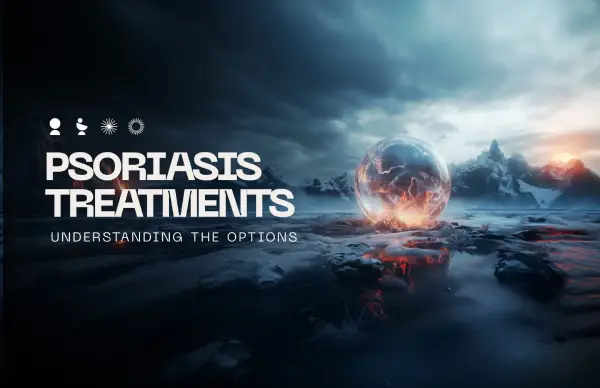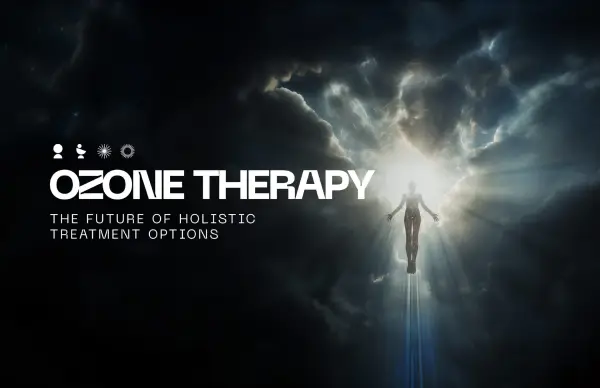Blog
What Is Ozone Therapy and How Does It Help With Psoriasis?

Contents
What is psoriasis?
What causes psoriasis?
Symptoms of psoriasis
Types of psoriasis
Psoriasis treatments
Ozone therapy for psoriasis
The future of ozone therapy in treating psoriasis
Could ozone therapy treat psoriasis? Many people with this health issue want to know.
Keep reading to know more about this autoimmune condition. Learn about the science behind ozone treatments. Discover the procedure and its benefits to decide if it suits your situation.
What is psoriasis?
Psoriasis is an autoimmune disease that affects more than eight million Americans.
The condition causes rapid multiplication of a person’s skin cells. These cells usually grow deep in the dermis, rise to the surface, and fall off. The normal process takes a month, on average, but with psoriasis, it happens in 3–4 days.
The cells accumulate on the surface instead of shedding, causing scaly patches. They’re usually whitish-silver and show up as reddish spots. The swelling parts sometimes burst and bleed.
Psoriasis generally affects joints, like the knees and elbows. The disease can also inflict other body parts, including:
- Feet
- Neck
- Scalp
- Hands
- Face
- Mouth
- Nails
- Genital area
This autoimmune disease is chronic, with no known cure. The occurrence is cyclical, appearing for a few weeks or months, then easing for a period.
Psoriasis is prevalent among folks with fair skin, but it can affect people of every race.
What causes psoriasis?
There are several things that can cause psoriasis. Let’s investigate them below.
Malfunctioning immune system
Immune system T-cells prevent illness by removing threats from viruses and bacteria. Psoriasis occurs when the immune system malfunctions. The white blood cells attack healthy cells, organs, and tissues.
There’s no cure for this autoimmune disease. The T-cells continue to attack skin cells for the rest of your life. The best defense is to support your immune system.
The only exception is guttate psoriasis. People diagnosed with this variant typically recover within a few months. Cases lasting longer than a year often result in chronic psoriasis.
Genetics
You have a higher risk of developing psoriasis if a relative has the disease.
While genetics play a role, some patients don’t have high-risk genes. Researchers also found that people with these genes never get the autoimmune disease. This information led them to believe other factors influence the onset of psoriasis.
Other potential triggers
Many things may trigger a first-time occurrence of psoriasis, including:
- Emotional stress
- Infections like strep throat
- Skin injuries (cuts, extreme sunburn, bug bites)
- Hormonal changes, especially during pregnancy or menopause
- Cold, dry weather
- Blood pressure medications, antibiotics, mood stabilizers, and NSAIDs
- Obesity
- Smoking
- Heavy alcohol consumption
Everyone has unique triggers. Something that induces flare-ups in one person may not affect another. It’s vital to know the cause of your psoriasis, as it might be a combination of triggers.
Psoriasis is also associated with several other conditions, including:
- Anxiety
- Depression
- Inflammatory bowel disease (IBS)
- Heart disease
- Type II diabetes
- Psoriatic arthritis
Psoriasis isn’t contagious. You can’t get the disease from someone.
Symptoms of psoriasis
Psoriasis can happen at any age, but symptoms usually appear between the ages of 15–25.
The most common signs of psoriasis include:
- Smudges on the skin. The patches look red on people with light skin. The affected areas appear purple or brown on darker skin.
- The red patches have whitish-silver scales. The flakes appear gray on brown and purple areas.
- Pain in the affected spots.
- Sore, swollen joints.
- Itching and burning feeling.
- Dry skin that may rupture and bleed.
- Thick, pitted nails.
Most people with psoriasis experience symptoms in cycles during their lives. They may go through days or weeks when the sensations are severe, followed by periods of ease. The condition reappears after a few weeks or when triggered. Some symptoms might disappear.
Types of psoriasis
Psoriasis comes in several forms, including:
- Plaque psoriasis is the most prevalent form. It affects 80–90% of patients. The symptoms appear as red, inflamed patches on light skin tones. Darker skin displays grayish, deep brown, or purple blotches. It’s often more difficult to identify.
- Nail psoriasis affects your fingernails and toenails. Symptoms include pitting, discoloration and abnormal growth. The condition may result in dislodged nails and, in severe cases, might cause them to crumble.
- Guttate psoriasis typically infects children. Small violet or pink patches appear on the legs, arms, and chest. There’s no swelling like with plaque psoriasis.
- Pustular psoriasis is more prevalent in adults. It usually affects the hands or feet, but symptoms may appear on other parts. They include swollen skin with red patches. There may be blisters and pus. The condition appears with more of a violet hue on darker skin.
- Inverse psoriasis causes bright red, swollen skin. You may notice the signs beneath the breasts or armpits. Patches may also show up in the groin or around the genital skinfolds.
- Erythrodermic psoriasis is a rare but severe form of the disease. The affected area is usually extensive and appears sunburned. You may get a fever and fall ill. The condition might be fatal in extreme cases.
Psoriasis treatments
Psoriasis has no cure, but there are treatments that may slow down rapid skin cell growth. These therapies also remove the scales.
The treatment you choose depends on the severity of the disease. The effectiveness of previous therapies also influences your decision. Try them out or combine the approaches to determine what works.
The available options include:
- Topical therapy: Applying creams and ointments on your skin.
- Phototherapy: Exposing your skin to certain types of ultraviolet (UV) light.
- Systemic medication: Consuming oral or injected drugs that work throughout the body.
- Natural alternative treatments: Holistic options that include ozone therapy.
Topical therapy
Doctors usually recommend topical treatments and moisturizer for mild to moderate psoriasis cases. These medications come as cream, ointment, foam, or a solution.
Topical therapy drugs are available over the counter or through prescriptions. They include:
- Corticosteroids decelerate immune cell growth in the skin. They reduce redness and swelling. You can get mild steroid creams over the counter. A doctor’s prescription is necessary for stronger doses. Note that there are reported side effects.
- Synthetic vitamin D supplements, like calcipotriene, slow skin cell growth. You may use them alone or combine them with steroid creams.
- Retinoids are synthetic vitamin A supplements that may ease psoriasis symptoms. Tazarotene, for example, impedes skin cell rapid growth and slows inflammation. Your doctor might pair it with a steroid to reduce the risk of skin irritation.
- Calcineurin inhibitors could ease rashes and reduce the accumulation of scales. They may also help around the eyes. Retinoids and steroid creams can be harmful or irritating in areas with thin skin.
- Salicylic acid is commonly available in shampoos. It reportedly softens and thins skin scales. Side effects may occur, like weakened hair follicles and temporary hair loss.
- Coal tar shampoo and ointments may reduce psoriasis itching, scaling, and inflammation. The side effects reportedly include dryness and redness. Your skin may also become more sensitive to UV light.
- Immunomodulators alter how your immune cells function. Use the creams on sensitive areas, like your face, skin folds, or groin.
Phototherapy
Phototherapy, or light therapy, treats moderate to severe psoriasis. Use the treatment alone or pair it with medications.
This method directs controlled amounts of natural or artificial light on the skin. It delays fast-growing skin cells in people with psoriasis.
Light treatment options include:
- Sunlight (heliotherapy). Briefly exposing your skin to daily sunlight may improve psoriasis symptoms.
- Goeckerman therapy. This approach combines light therapy with coal tar treatment.
- UVB narrowband. This treatment focuses UV light on affected skin areas. It’s said to be safe for pregnant or breastfeeding women and children. People with a weakened immune system or illness may also benefit.
- UVB broadband. Doctors expose a broader area to UV light. This treatment isn’t as effective as UVB narrowband.
- Psoralen plus ultraviolet A (PUVA). This treatment combines psoralen with ultraviolet A (UVA) light. The former boosts the amount of UVA your skin absorbs. Although the therapy isn’t widely used, it’s said to be effective for psoriasis.
- Excimer laser. This light therapy exposes red patches to ultraviolet B (UVB) rays. The artificial light only targets affected areas and removes smudges.
Systemic medication
Systemic medication may help people with moderate to severe cases of psoriasis. Doctors usually prescribe these drugs when other treatments fail. Avoid using them for prolonged periods, as they may cause serious side effects.
The psoriasis medications include:
- Steroids: Triamcinolone injections potentially help people with mild psoriasis symptoms.
- Retinoids: Vitamin A pills may reduce skin cell production. They also slow down the cell build-up on the surface.
- Biologics: These medications affect the immune system. Most conditions usually improve within weeks after the disruption of the disease cycle.
- Methotrexate: This oral drug may lower skin cell production and stop inflammation.
- Cyclosporine: This oral drug may subdue the immune system.
Natural alternative treatments
Some studies report alternative treatments may soothe psoriasis symptoms. These natural therapies include:
- Salt baths. Soaking in a warm bath with Dead Sea or Epsom salts for 15 minutes may remove scales and reduce itching. Applying moisturizer after the bath ensures your skin doesn’t get too dry.
- Colloidal oatmeal. Soaking in an oatmeal bath or applying a paste could relieve redness and itchiness. There isn’t much evidence that proves the efficacy of this treatment for psoriasis.
- Aloe vera. Applying a cream with 0.5% aloe vera may reduce scales and redness for a brief period.
- Apple cider vinegar. This solution may relieve itching from scalp psoriasis. Ensure the mix contains more water than vinegar, as the latter can burn your skin. Avoid applying the liquid on open wounds.
- Healthy diet. Experts say excess weight worsens inflammation and disrupts the immune system’s effectiveness. Losing a few pounds might help your condition if you’re overweight.
- Ozone therapy. This treatment adds oxygen supply to your body. The process typically kills bacteria and helps heal wounds and diseases.
Ozone therapy for psoriasis
Ozone therapy is a holistic alternative for people seeking relief from psoriasis. This non‐invasive treatment targets skin problems like ulcers, dermatosis, and infections.
The science behind ozone therapy
Ozone gas, comprising three oxygen atoms (O3), improves oxidizing activity.
According to research, ozone gas creates more red blood cells and proteins. This reaction increases the oxygen supply in your body. The high oxygen environment destroys illness-causing pathogens, as the microorganisms can’t survive in such conditions.
Low ozone doses may heal wounds, modulate immunity, and reduce pain.
Is ozone therapy effective in treating psoriasis?
Studies show ozone gas influences the body to create free radical scavenging agents. These microorganisms destroy the molecules produced by inflammatory reactions.
The findings indicate that ozone therapy is safe and effective. There’s no cure for psoriasis. But this natural treatment could significantly improve your symptoms.
What does ozone therapy entail?
We provide ozone therapy in two ways:
- Intravenous (IV) ozone: Ozone is administered directly into your bloodstream, promoting full-body effects.
- Ozone insufflation: Ozone is administered directly into a specific body part, resulting in a more localized effect.
Other treatment methods include ozonated water, ozonated ointments, autohemotherapy, and ozonated baths.
Ensure you get a good night’s sleep before your procedure. Avoid drinking alcohol, keep hydrated, and eat a hearty breakfast on the day of the treatment.
Does ozone therapy have any side effects?
According to some research, ozone therapy may have limited side effects. Another study claims that it rarely leads to systemic side effects.
Check with your doctor before starting treatment to ensure it suits your condition. Your physician will recommend the correct therapy for your psoriasis type and severity.
Some patients can’t undergo ozone treatments. They include:
- People with hemophilia or anemia.
- People who recently had a heart attack.
- People who are menstruating or pregnant.
The future of ozone therapy in treating psoriasis
Psoriasis is an incurable autoimmune disease, but there’s hope for diagnosed patients. Many treatment options reportedly ease symptoms and offer a higher quality of life. One of the latest therapies to hit the industry is ozone.
The ozone therapy benefits are vast. This treatment method is natural, non-invasive, safe, and effective.
Do you want to discover the benefits of ozone for psoriasis? Book a consultation with LIVV Natural to chat to our experts. We’ll formulate a specific treatment plan to help you reach your goals.
Author: Dr. Jason Phan NMD – Founder of LIVV Natural – Anti-aging – regenerative medicine – peptide therapy


